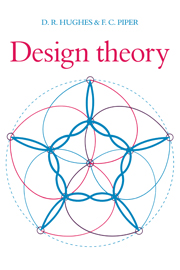3 - Some families of symmetric designs
Published online by Cambridge University Press: 08 January 2010
Summary
Introduction
In this chapter we continue the study of symmetric designs but in a somewhat more specific way than in Chapter 2. Section 3.2 contains a detailed discussion of the relation between projective and affine planes and develops some of the theory of non-desarguesian planes. (This latter development is primarily concerned with translation planes, quasifields and semifields. It has a different algebraic flavour than the rest of the book and, although the results are important, the proofs may be skipped if necessary.) Affine planes lead naturally to a discussion of latin squares in Section 3.3 followed by nets which are a very important class of 1-designs; in Section 3.4 one of the applications of nets discussed is the construction of a new infinite family of symmetric designs. Section 3.5 deals with Hadamard designs and Hadamard matrices and contains a construction of the Paley designs. Section 3.6 has a fairly detailed discussion of biplanes (symmetric designs with λ = 2). In Section 3.7 we study the special class of graphs called ‘strongly regular’ and develop their elementary theory (e.g. eigenvalues and multiplicities), as well as giving a number of infinite families. Such graphs enable us to construct some new symmetric designs, and in addition they will be used again later in the book (see Chapters 7 and 8). The connections between strongly regular graphs and design theory are among the most important examples of the fruitful relationship between graphs and designs.
- Type
- Chapter
- Information
- Design Theory , pp. 83 - 126Publisher: Cambridge University PressPrint publication year: 1985



